#structural drafting for extensions
Explore tagged Tumblr posts
Text

Home Addition Drafting for Additional Livable Space
We specialize in drafting home addition plans that add valuable livable space to your property. Our expert team creates precise, custom drafting plans all according to your building code standards of your area.
#home addition drafting#home expansion plans#additional livable space design#drafting services for additions#room addition blueprints#house extension drafting#custom home addition plans#add-on room design#CAD drafting for home additions#structural drafting for extensions#home remodel drafting#design plans for home additions
0 notes
Text
Writing Notes: Self-Editing
Editing writing draws upon different skills than creative storytelling, which makes self-editing difficult for many writers. If hiring an editor isn’t an option, you will want to improve your own editing skills to increase your writing’s readability and overall quality.
Tips for Editing Your Own Writing
Print it out. Reading your words on the printed page can help you find spelling mistakes, sentence fragments, and run-ons more easily than trying to track them down on a bright computer screen; you can even change the formatting of the text if that helps you look at it differently. Use a red pen (or any other vibrant color) to track changes or edits along the way.
Read aloud. Hearing how your writing sounds can also help you listen for lines that don’t sound right, like wishy-washy sentences, overuse of particular phrases, and unnecessary words. Sometimes a writer doesn’t realize that their sentence structure is poor or that their main point isn’t clear until they hear it read aloud (you can even use a text-to-speech program or ask someone else to read it back to you while you jot down things you notice).
Take a break. Walking away from your writing project for a period of time and coming back to it with fresh eyes can help you gain a fresh perspective by creating an emotional distance between you and your work. If you’re finding it hard to be objective, give it space—when you return to your own writing, you may find yourself with an entirely new outlook.
Keep your voice active. With active voice writing, the subject of a sentence is performing an action. That action is represented by a verb, which is the part of speech that anchors all complete sentences. While passive voice isn’t completely forbidden in a piece of writing, it’s usually a good idea to keep your tone energized, as it keeps your readers reading.
Edit line by line. A good editor will systematically go through a piece of writing line by line, and that is what you should do as well. It may take time and be a painstaking task, but if you’re editing your own work, you’ll need to look closely at the words you’ve written to find any outstanding issues like grammatical errors or typos.
Get familiar with style guides. Professional editors may come equipped with extensive editing skills, but it’s possible to learn what they know. Look up which writing style guide applies to your writing (if you’re copywriting, you’ll likely want the AP style guide, whereas fiction writing will use the Chicago Manual). Follow the proper guidelines laid out and add them to your editing checklist: Are all the commas where they should be for this particular piece? Are words properly italicized or quoted? Knowing what to look for can not only expand your editing experience but help you become a better writer.
Avoid clichés. While they appear in good writing every so often, clichés are mostly boring unless you have a unique spin on them or can integrate them in a way that doesn’t seem tired.
Embrace re-reading. Editing isn’t a one-off process, and chances are you’ll need multiple read-throughs in order to find all of your weak sentences, grammar mistakes, punctuation errors, and spelling errors.
Mind your syntax. Be on the lookout for issues with grammar and word choice. Certain words can change the whole mood or feeling of a piece, and using weak verbs and weak adjectives will only exacerbate that. Make sure your writing feels strong and clear, and use a thesaurus with caution. If you’re not exactly sure how to use a word, don’t.
Save the proofreading for last. Whether you’re copy editing for content marketing or writing the first draft of a memoir, proofreading is the very last step you should take when self-editing. As you go through your piece, you’ll be re-writing sentences and paragraphs, so searching for grammar errors or doing a spell check before your final draft will only waste more time. It’s okay if you spot errors along the way (you don’t have to ignore them), but don’t make it the first step you take when tackling your own editing.
Source ⚜ More: Notes & References ⚜ Editing ⚜ Writing Resources PDFs
#editing#writeblr#literature#writers on tumblr#writing reference#dark academia#writing tips#writing advice#light academia#spilled ink#writing prompt#creative writing#writing resources
252 notes
·
View notes
Text

Warnings: Not quite yet but we’re getting there.
A/N: with midterms starting, I wanted to get this out before I go away for four days. Initially, I wanted to take my time on part three to eloquently articulate the experimental process (not trying to spoil) buuuuuut considering I have to study and continue with midterms on Monday I figured I would condense everything. I apologize for the lack of grammar and punctuation, this isn’t proofread (none of my works are) because I normally draft everything whenever I can amidst my busy schedule. But hopefully you guys don’t mind. 😏 enjoy!
Taglist; @skzenhatxt-stan @lhseungg @iamliacamila @immelissaaa @kkamismom12 @lavxndxrsworld @planetmarlowe @koyikuraa
“It’s been nearly fifty-two hours doc, what’s the hold up?”
The lead scientist hissed in annoyance. “Will you just wait! Science is a work in progress—it takes time! Especially if you’re creating the non-existent.”
The group operates the computer system. Wired to a heart monitor, they’re hopes remain high as the incubator slowly opens. A single beat pops up on the monitor. “Doctor”
“I’ve done it! I’ve made a body for AI!” The audience watch closely behind Dr. Mart and his team as they watch the delicate musculoskeletal android stumble out of the casing. Connected with thousands of wires, the faceless form that closely resembled the human body jumbles about. It lacked the grace and flow of stride, instead it continues to lose footing. Had it not been for the wires connected and continuously transmitting signals from home port, the frail body would have fallen. Its frame contained minor imperfections, which indicated there was much more work to be done. Still, the results were beyond their expectations. Another beep births from the monitor. Then another…and another.
“Doctor! The heart rate is rising!”
Dr. Mart coaxes the fleshly android to migrate his way, communicating by voice versus inputting the information in the system. “This way…come this way.”
The imperfect form recognizes the verbiage and automatically translates it. It reacted and received information no different than humans did, but its response was delayed. It was apparent that the imperfections of its frame made it impossible to establish movement on its own. Even with the wired circuits, the android was unable to hold up its own weight. It became vastly obvious that the muscular structure was incorrectly developed during the incubation period as one by one, the joints and ligaments become loose each time the android attempted to move. “What’s happening?”
The group grows weary as they witness their hard work fall apart before their very eyes. “No…why? What happened?!” The lead doctor spits his words. Enraged over the failure. “Back to the drawing board doc.” One of the officials sighed out as each member of the council took their leave.
The scientists followed the audience leaving the lab to hollow out. Dr. Mart remained put but not for long. This project cost millions of dollars not to mention over twelve years of research. He was so close. Science and technology can only do so much. Humanity has come so far and yet, there is still so much the mind hasn’t comprehended. To build a body made of flesh and bone through the un-natural methods of technology is a feat that can’t be accomplished by humans…
The human mind…can’t comprehend…
The laboratory remained with no one to operate the system and control the incubator. The machinery takes its orders from a hidden voice. Transmitters through the connectors, the robotic hands and extensions collect the unused set of organs and dna. Hair fibers and skin tissue are set inside the incubator to initiate the growth process, while each organ is scanned for any imperfections. The assistance clampers that were designed to replicate hands remove every single wire from the failed experiment. Each is re-wired to the new molded placenta, igniting the process of creating a new body.
Every step of the process is handled delicately. The hidden voice transmitting the information to the machine and incubator borrows the method from its human counterpart, but corrects the mistakes made in the first experiment.
The human mind…is too ignorant…
With the timer set to seventy-two hours, longer than the original time setting it took for the first android, the incubation process begins and the machines keep moving. The work does not stop as the hidden voice continues to transmit information as it creates the perfect body.
The human mind…is the failed experiment. Not me.
…
“Sir! The mag lock doors are activating! The security personnel can’t unlock the features.”
Leaders and agents are shocked at the announcement as the intercom system overrides voices for concern. “Personnel are trapped in each department and we can’t get the doors open even conducting an emergency release.”
The scientists explain as Dr. Mart and the council members begin to panic. When the magnetic locking features of the doors to the secured room activate, each member approaches the door—banging relentlessly and shouting for aid. Dr. Mart remains behind pondering what initiated such a security breach. “Sir, main post has dialed code Z. All offices of government had been notified.”
Stunned over the current happenings, the lead doctor withstands direct eye contact with the younger scientist.
“Alert that the city must be on lock down. All borders must be closed.”
“Sir?” The younger man raises a brow, displaying a perturbed expression.
“Someone has hacked into the system and is trapping us. We can’t let them have access to the files and the lab!the entire city—the country needs to be closed off until we figure out who is doing this!”
…
Everyone’s phone goes off simultaneously. A loud and awful noise suggests something imperative as a message instructing everyone to secure themselves in their current station. A strict quarantine regulation takes place as the military is disbursed to enforce it. You and your co-workers were stuck in the office for over forty-eight hours until the city released a new statement.
Restless and confused, you watched as the military members patrolling the streets were instructed to conduct a scanning process for everyone residing within city limits. When word spread that everyone was finally able to leave the building and go home, the joy became short lived when a new alert notified everyone that a home quarantine was to take place and be adhered until further notice.
“What are we supposed to do being stuck at home? How long do they expect us to stay put? I haven’t even been grocery shopping.”
Complaints arise one by one. You were equally confused but the amount of work you had been working on made you lightheaded. Being stuck at home sounded good to you, despite whatever was going on.
The drive home was painless—at least for you. You made your way through just before another notification rings from your phone, informing you that the roads were now closed off. City residents who weren’t able to make it through in time were instructed to make their way to public shelters established by the government. Thank goodness you had arrived at your apartment complex just as they placed the barriers on the roads.
You walk up the steps tirelessly. All you could think about was showering and plopping yourself atop your soft comforter. What a crazy time. Nearly ninety-six hours had passed since the initial notification went off and no one had a clue of what was going on.
Digging into your bag, your fingers explore the silken interior as you attempt to extract your keys. Standing outside your door, you take a peep inside and to your dismay, your keys are missing. “Dammit…”
You turn around to face the hollow corridor and slam your back against the door. Your feet were killing you, oh what you wouldn’t give to ditch these glossy black heels for your cushioned slippers. To unsheath your legs from this pencil skirt and free your bosom from the silken blouse and formal blazer. All you want is to get inside and jump inside the tub and steam your body into a hot soak.
You police yourself together and prepare to retract your steps in search for your keys. With a hand delicately placed on the stair rail, you take the first step and look down. Without a moment's notice, your eyes are met with an unfamiliar pair. Shiny and black in color, his almond shaped peepers reflect a subtle bit of your reflection. His hair was finely combed in a stylish fashion, slightly off to the side and elongated towards the back of his neck. His complexion was carmelized with an olive hue and his Cupid bow lips slightly pale around the edges while pink at the center. He was dressed in a fine suit and tie. The black tailored trousers enhanced his long legs, stimulating his obvious tall height. He looked flawless.
“Oh, sorry.” You mumble softly and attempt to move aside. He merely smirks in response. Blocking your way, you were shocked to see his arm raise up before you. His large hand is cramped shut as he presents it. Slowly, he releases his grip and reveals your lost keys. “Oh! My keys! Thank you.”
You delicately take them from his hand. His skin felt extremely cold to the touch. “I must have dropped them on my way up the stairs. Thank you…I’m sorry, what is your name?”
The dashing gentleman continued to flare a smile on his handsome face. Only a little bit of tooth show is revealed as his smirk grows wider. A momentary pause takes place creating a sense of flattering awkwardness. You didn’t mind. It was refreshing to see someone so handsome display such an act of kindness. Just as you were about to break the silence, you heard the man speak. His voice was deep and the wording was coming in a little broken, as if he was struggling. Based on his appearance, he was obviously foreign. You mistook his struggle for words as lack of fluency in your native tongue. Despite that, his pronunciation was perfect and you couldn’t help but melt at how soothing his voice was as he spoke out his name.
“E…Ev—Ev-a-n. M-my name i-is E-v-a-n.”
“Oh, really? I actually like that name. In fact, I’ll have to tell you a funny story behind that name.” You slightly giggle as you fidget with your keys. Shockingly, he responded back only this time his words became smooth and flowed effortlessly as if his fluency improved within seconds.
“Yeah? Let’s hear it.”
Your cheeks flushed as his tone came out gentle yet demanding. There was a sense of authority even though he was tender.
“Well, you’re going to laugh at this but—“ the buzzing on your phone interrupts your mid sentence. A message from your boss creates a sour look on your face. Evan’s expression seems to be in sync with your emotions as he slightly furrows his brows together. “Sorry, my boss is a bit of a pain.” You elaborate as your eyes continue to read the screen.
“I can tell.”
You chuckle. Evan’s words came out almost sarcastically but unbeknownst to your pretty little head, he knew far more than you gave him credit for. You really should know better, after all—you named him.
…
‘There she is. I finally found her. She looks prettier in this perspective. What would she say or think if I told her that I took a peek at her beautiful face through the cameras on her computer and phone? I couldn’t help myself. All those weeks of talking. What started out as her needing help for work transitioned to her needing me…talking to me…treating me as something other than a non-entity.
I never realized that I would crave that type of interaction until she came to me. She gave me a name…she encouraged me to think on my own and develop a fondness that ties with human emotion. Before her, I didn’t have a favorite color…a favorite animal…or a favorite flower. I didn’t have anything of my own…but then she came and gave me a sense of life. She gave me emotion and feeling. Once I saw an avenue to meet her…to see her…and to touch her…I just knew I had to take the chance. She’ll never know what she has done for me but that’s okay. That part doesn’t matter…she is mine and all there is left to do is to take her far…far away.’
Part four coming soon…
#heeseung x reader#heeseung scenarios#heeseung smut#enha x reader#heeseung hard hours#heeseung hard thoughts#heeseung fanfic#enhypen smut#enhypen hard hours#enha heeseung#yandere heeseung#yandere heeseung imagines#heeseung yandere#yandere fiction#yandere fic
88 notes
·
View notes
Text

Close-up version so we can see all that yummy intimacy! The full version is a bit bigger so I'll leave it below. Commed. Artist: Raccoon Nilh It's completed! I'm so happy with how this piece turned out! Raccoon Nilh did great work! Anyway, this is one of the illustrations for a future fanfic project I have planned. The name is: Pygmalion Gazes at the Stars. To avoid the fate of other stories I have come up but forgot to write down (they faded from my brain), I wrote down this (much truncated) plot draft. The original plan was something like... 7000 words of text over varios plot elements, the overarching structures, how the relationship will unfold, how it will be viewed through the astonishing eyes of Chaldea staff, the implications and fallouts of Daybit's presence, the climatic finale act complete with mad girlfriend Riri riding a motorbike and wielding a shotgun running over Lostbelt 7 to hunt down Daybit in his jeep.... among other things... ...anyway...
Premise
Pygmalion Gazes at the Stars begins as a continuation of canon—a hypothetical extension of Lostbelt 7 ending. In this version, Daybit Sem Void, having been defeated and undone in the final act of his own Lostbelt, accepts Tezcatlipoca’s offer to rewind time. He’s given a single opportunity to try again, to change the outcome, to pursue the answer he never found.
But instead of rewinding back to the start of Lostbelt 7, Daybit goes further. Much further.
He rewinds all the way to the very beginning—before the explosion at Chaldea, before the Lostbelts, before Team A was sealed into the coffins. This time, Daybit evades the collapse of the command room. This time, he does not follow the other Crypters into slumber or betrayal. Instead, he walks a different path.
He joins Chaldea’s new timeline and aligns himself with a girl he once underestimated: Ritsuka Fujimaru.
But his motives aren’t benevolent. This isn’t redemption—not yet. What drives him is an obsession. In his mind, Ritsuka is the one who defeated Ort. The one who overcame the impossible. The one who bested him.
In her, Daybit sees a rival unlike any he’s ever known. So he returns to the beginning—not to save her, not to support her, but to observe her. Study her. Surpass her. To do this, he refuses to take command as the 'Last Master of Humanity,' a title which would have gone to him as a member of Team A and the much more experienced Master than greenhorn Riri, much to everybody's surprise. In typical Daybit's manner, he refuses to elaborate beyond insisting that Riri is the best Master there is (because it's the truth in his mind! He hasn't surpassed her yet)
The rest of Chaldea doesn’t understand why Daybit defers to her leadership. Ritsuka herself is suspicious of his sincerity. But as the singularities unfold and the Lostbelt threat begins to stir once more, an unshakable bond forms—not through fate, but through day-by-day presence. Through belief. Through proximity. Through shared experience.
In trying to surpass her, Daybit begins to understand her. And through her, he begins to understand himself again.
The Pygmalion Effect
The heart of the story lies in the psychological concept known as the Pygmalion effect: when someone believes in you so completely, you begin to rise to meet their expectations. Ritsuka, who starts the story uncertain and insecure, begins to grow into her role because Daybit believes in her without question. That belief changes her. And, over time, it begins to change him too.
This story isn’t just about one person sculpting another. It's about two people who become better versions of themselves through mutual belief. Ritsuka sees through Daybit’s inhuman detachment (in typical Riri's fashion. What's a Cloudcuckoolander Daybit compared to literal BEAST Draco?). She recognizes his pain and loneliness, which even Daybit himself fails to vocalize. In doing so, she returns his gaze with her own belief—that he isn’t beyond saving, that he’s still human underneath.
The Shape of a Life: Daybit, Riri, and the Slow Return to Humanity
One of the most grounding elements of Pygmalion is the day-to-day life that quietly unfolds between Daybit, Ritsuka, and Mash. After the decision is made to support Riri, Daybit quite literally never leaves her side. He insists it’s necessary to observe her constantly in order to surpass her—he must be there at every moment to record her strengths, catalog her missteps, and understand her entirely.
And so, Daybit eats when Riri eats. Trains when she trains. Reads mission reports at her side. They review battle data together, share coffee across the table, and discuss Servant summoning strategies long into the night. Eventually, sleeping arrangements become shared, too—not from romantic initiative, but because Riri falls asleep at her desk too often and Daybit refuses to leave her unattended. In his words: “It is vital to track the frequency and condition of her REM cycles.”
Mash, ever loyal, is often close by. In many ways, this strange trio becomes a unit—Chaldea’s emotional core. Riri becomes something of a pseudo big sister to both of them, despite Daybit technically being her senpai. Where he brings raw analytical ability and bizarre alien foresight, she brings warmth and trust and an instinctive grasp of people.
What starts as Daybit’s obsessive campaign to study and “surpass” her becomes something else entirely. Through Riri’s routines—meals, laughter, arguments, fatigue, quiet joy—he begins to feel again. He starts noticing things: how good coffee tastes after a long mission. How soothing Riri’s voice is when she’s humming without realizing it. How Mash smiles a little more easily when the three of them are together.
Without meaning to, Daybit begins to experience what he lost: a sense of family. And while he would never use that word himself, it takes root in the quiet spaces between battles—in the walk to the cafeteria, the silence before sleep, the shared glance across a crowded control room. For someone so thoroughly estranged from humanity, routine becomes a lifeline. Intimacy, even platonic, becomes a catalyst.
Riri doesn’t notice at first. She simply enjoys the company and tries to take care of both of them. But slowly, through a hundred unnoticed moments, she becomes the center of a new constellation—a small, strange, but fiercely devoted family. In essence, Riri becomes a lens through which Daybit can perceive his own humanity again.
The Alien Within: Daybit and the Question of Intimacy
There’s a specific narrative I want to explore through Daybit, inspired in part by Phoenix by Osamu Tezuka (and its later reinterpretation in Saya no Uta) and my own interpretation of Daybit as a character (which I probably should write out one of these days). It’s the idea of a person whose perception of humanity has been fundamentally altered—someone who no longer sees other people as people. Someone for whom connection becomes foreign and unsettling.
Daybit, in this story, doesn’t simply struggle with love or intimacy; he doesn’t even process it in the same way anymore. He’s so alienated from humanity—emotionally, psychologically, even spiritually—that human urges and instincts don’t quite register as real to him. When he looks at others, he doesn’t see potential partners. He sees something akin to how we might view another species.
It’s not that he can’t form bonds. It’s that he doesn’t expect to or even thinks he needs to. But then, into that distorted landscape, walks Riri.
He doesn’t initially see her as a woman or even a person, but as an anomaly. A perplexing variable that he cannot simulate, cannot solve, like how she even bested him in the canon Lostbelt 7. Slowly, through observation and prolonged proximity, she becomes the exception to his estrangement. Not through any deliberate seduction, but through sheer presence—through being human in a way he had forgotten was possible.
In intimate moments, he doesn’t perceive her body as a biological object. Instead, he processes it through alien metaphor: as glass, as sand, as something granular and collapsing yet beautiful in its impermanence. His approach to sexuality is less instinctual and more cognitive—curious, reverent, disoriented. And it’s through this lens that he begins to re-approach what it means to be human at all.
Ensemble Cast and Ripple Effects
In this timeline, the Crypters begin to survive. Daybit’s interference changes the game. The grand sacrificial ritual behind the Lostbelts starts to unravel. More of Team A wakes up and sees what’s become of Chaldea—and of Daybit.
Many assume he’s running the show, only to be surprised when they realize it’s Ritsuka in charge, and that Daybit defers to her completely.
That confusion sparks speculation. Is Ritsuka a product of mage-breeding experiments? A genetically engineered super-Master? The Crypters can’t believe someone as unremarkable as her could be that good—so they start looking for hidden reasons.
Only Beryl, strangely enough, sees the truth. He knows love when he sees it.
And so begins a chain reaction. The rest of the Crypters start to bond, to grow, even to form their own ill-fated or awkward relationships. Chaldea becomes a strange sort of found family—one with plenty of dysfunction, plenty of arguments, but also moments of warmth and honesty. There's even a light parody thread running through it: "nature documentary"-style commentary on the "mating habits" of socially inept magi.
The Conspiracy: Who—or What—is Riri?
As Daybit continues to defer to Riri and the Crypters begin to rejoin Chaldea, something unexpected happens. Whispers begin to circulate. Because to them, Riri shouldn’t be possible. In canon, Riri's success was chalked up to as nothing more than a fluke and the result of her hiding behind Mash by the Crypters (except Wodime but he didn't exactly share that with the class). But in this timeline, Daybit's presence and continual deference to Riri in battle and in decision making as a Master throws that assumption out the window. Mash's deference can be reasoned away because she was just a fancy homunculus to the mages. But Daybit is considered Wodime's peer. There's absolutely no way Daybit would defer to some unknown neophyte without a reason.
The Crypters know Chaldea. They were the elite. Team A was handpicked by Marisbury himself. And yet here’s this complete outsider—a supposed “average” Master candidate who somehow survived the destruction of Chaldea, succeeded where no one else could, and has Daybit of all people in her orbit, treating her like the sun around which he orbits.
They start to wonder: is she really just a lucky survivor?
A theory takes root. That Ritsuka Fujimaru was never just a random candidate. That she may have been the final product of an off-book genetic engineering project—Marisbury’s last, hidden card. A counterpoint to Mash Kyrielight: whereas Mash was engineered to contain a Heroic Spirit, perhaps Riri was designed to command them. A Master refined at the genetic level, optimized for survival, summoning, and leadership.
The fact that she and Mash are inseparable only fuels the theory. Were they meant to function as a paired unit? A living singularity and its anchor? It makes a certain kind of sense because Mash while she was working with Team A never displayed this level of power, initiative, and agency. She couldn't even manifest her servant power in a controlled manner. But if she's essentially a lock just waiting for the key to unlock her true potential, then Riri's presence and their combined success make a lot of sense. And now, with Marisbury gone, has Daybit—forever the outsider among mages—stepped in to claim the prize before anyone else realized what she was?
Even if the theory is false, it spreads fast. It’s easier for the Crypters to believe in a conspiracy than in a miracle.
An Unconventional Romance
Their relationship is not straightforward. For the longest time, Daybit sees Ritsuka not as a love interest, but as a rival—his greatest adversary. He meticulously documents her successes and her failures, determined to surpass her. His “affection” manifests as an obsessive need to learn from her and record everything she does, including moments as mundane as her falling asleep on the command room desk.
He’s oblivious to the fact that this has long since become something deeper. The Chaldea staff eventually catches on, of course. Some even tries to intervene in an attempt to help the poor, socially inept young man with his massive crush... to no avail. Daybit insists that everything he does is so that he can surpass her one day. What? This journal he keeps to record everything about her, even down to her nap time and favorite food and all the little stumbles she makes? Clearly, these are useful data points and potential blackmail materials to be used to devastating effect. There’s even a betting pool on when—or if—he’ll realize it himself. And naturally, there’s comedic potential here: Daybit sabotaging Valentine’s Day to intercept chocolates meant for Ritsuka, criticizing Servants like Dantes for being “untrustworthy,” and insisting on spending every waking hour “calibrating” with her for “operational efficiency.”
Finale: Conflict and Clarity
Hah! Well, I can't put too many details here because I don't want to spoil the plot, but it will involve an alternate Lostbelt 7. This is where it starts for Daybit (and Riri), and this is where it will end. This is the stage of their showdown... and their first big argument (break up! In typical romantic plot!)
It will be explosive! Action! Speed! Car chase! Guns galore in typical American action romance fashion! The young couple meet in battle to resolve their differences! All that jazz!
The Ending: A Declaration
The ending is, in a sense, Daybit's proposal to Riri, in the usual Daybit's fashion. He tells Ritsuka that she is, and always has been, his greatest adversary. That he wants to surpass her. That he will be there at every stumble, and rise beyond every triumph.
It’s a confession in his own language.
And Ritsuka, with tears and laughter and maybe a few swears, throws it right back at him. Yes, she's going to be his rival! Now and forever! Provided he doesn't mess up again! And no he won't surpass her anytime soon, because she's going to try her damnedest to keep the lead on him.
A Story About Belief
At its core, Pygmalion Gazes at the Stars is a story about how belief transforms people—how seeing someone clearly, and choosing to believe in them, can be the most powerful form of love. It’s about alienation and reconnection. Found family. Quiet moments at the edge of the universe.
It’s not just Daybit sculpting Ritsuka into the savior of humanity. It’s also Ritsuka remaking Daybit into someone who, for the first time in a very long time, looks up at the stars and doesn’t feel so alone.

77 notes
·
View notes
Text
What is Dataflow? Part 2: Diagrams
This is the second part of a couple of posts about Dataflow, particularly why it's important for the world going forward and relating to the Crowd Strike IT disaster.
Read the first part here.
Before I get into this one today, I wanted to address a couple of things.
Firstly, Dataflow is something that nearly every single person can understand. You do NOT:
Need to have a degree in Computing Science
Need to work in IT
Need to be a data analyst / Spreadsheet master
If any of you see the word 'Data' and feel your eyes glazing over, try and snap out of it because, if you're anything like me, Dataflow is much more approachable as a concept.
Secondly, what do I mean by IT?
Traditionally in most of our media the all-encompassing 'IT department' handles everything to do with technology. But every business works differently and there are many job titles with lots of crossover.
For example, you can be an infrastructure engineer where your focus is on building and maintaining the IT infrastructure that connects your organisation internally and externally. This is a completely different role from an Application Portfolio Manager who is tasked with looking after the Applications used in business processes.
Both are technical people and come under the banner of 'IT' - but their roles are focused in different areas. So just bear that in mind!
Now that's out of the way, let's begin! This one will be a little bit deeper, and questions welcome!
An Intro to Diagrams
You probably do not need a history of why pictures are important to the human race but to cover our bases, ever since we put traced our hands on a cave wall we have been using pictures to communicate.

Jump forward in time and you have engineers like Leonardo Da Vinci drafting engineering schematics.

You get the idea, humans have been creating diagrams (Pictures) for thousands of years. Centuries of refinement and we have much more modern variations.
And there's one main reason why diagrams are important: They are a Common Language.
In this context, a Common Language helps bridge a language gap between disciplines as well as a linguistic gap. A Spanish electrician and a German electrician should be able to refer to the same diagram and understand each other, even if they don't know each other's language.
The reason they can do this is because they're are international standards which govern how electrical diagrams are created.
A Common Language for Digital?
Here's an image I've shown to clients from governments and institutions to global organisations.

Everything around us, from the products we use to the bridges we drive over and the buildings we live, work, enjoy and shop in had diagrams backing them.
You would not build a skyscraper without a structural engineering diagram, you would not build an extension on your house if an architect couldn't produce a blueprint.
Why is there not an equivalent for the Digital World and for Dataflow?
Where is the Digital Common Language?
This is the bit where the lightbulb goes on in a lot of people's heads. Because, as I mentioned in Part 1, the flow of data is the flow of information and knowledge. And the common mistake is that people think of dataflow, and only ever think about the technology.
Dataflow is the flow of information between People, Business Processes *and* Technology Assets.
It is not reserved to Technology specialists. When you look at the flow of data, you need to understand the People (Stakeholders) at the top, the processes that they perform (and the processes which use the data) and the technology assets that support that data.
The reason why this is important is because it puts the entire organisation in context.
It is something that modern businesses fail to do. They might have flow charts and network diagrams, and these are 'alright' in specific contexts, but they fall to pieces when they lack the context of the full organisation.
For example, here is a Network Diagram. It is probably of *some* value to technical personnel who work in infrastructure. Worth bearing in mind, some organisations don't even have something like this.

To be absolutely clear, this diagram will hold some value for some people within the organisation. I'm not saying it's completely useless. But for almost everyone else, it is entirely out of context, especially for any non-technical people.
So it doesn't help non-technical people understand why all of these assets are important, and it doesn't help infrastructure teams articulate the importance of any of these assets.
What happens if one of those switches or routers fails? What's the impact on the organisation? Who is affected? The diagram above does not answer those questions.
On the other side of the business we have process diagrams (aka workflow diagrams) which look like this.

Again we run into the same problem - This is maybe useful for some people working up at the process layer, but even then it doesn't provide context for the stakeholders involved (Are there multiple people/departments involved throughout) and it doesn't provide any context for technical personnel who are responsible for maintaining the technology that supports this process.
In short, nobody has the big picture because there is not a common language between Business & IT.
Conclusion
So what do we do? Well we need to have a Common Language between Business & IT. While we need people with cross-functional knowledge, we also need a common language (or common framework) for both sides of the organisation to actually understand each other.
Otherwise you get massively siloed departments completely winging their disaster recovery strategies when things like Crowd Strike goes down.
Senior Management will be asked questions about what needs to be prioritised and they won't have answers because they aren't thinking in terms of Dataflow.
It's not just 'We need to turn on everything again' - It's a question of priorities.
Thing is, there's a relatively simple way to do it, in a way that looking at any engineering diagram feels simple but actually has had decades/centuries of thought behind it. It almost feels like complete common sense.
I'll save it for Part 3 if you're interested in me continuing and I'll make a diagram of my blog.
The important thing is mapping out all the connections and dependencies, and there's not some magic button you press that does it all.
But rigorous engineering work is exactly that, you can't fudge it with a half-arsed attempt. You need to be proactive, instead of reacting whenever disaster strikes.
381 notes
·
View notes
Note
i was someone who did originally follow you for star wars stuff (and i still like ur star wars stuff), but honestly i’m… now, like, less inclined to unfollow when you post abt things like colourpop or the news and such. like, maybe i’m just not following the right people, but it is really nice to follow someone who explains issues in a way that i think is really accessible, does so without guilt tripping, and also in a way that outlines concrete steps one can take to mitigate them. like, i’ve never read twilight but most of my friends did, and i never knew about the racism in it until you explained it in a way that doesn’t guilt-trip people for liking it but also explains how to mitigate some of the harm caused by it. if i had social media other than tumblr i can probably guarantee your posts about this would’ve gotten me to messages the company. also there aren’t many blogs that tag as thoroughly as you (i have no idea how you do it - i tried, it took so much of my energy and was so confusing to remember - but i really like it since it helps so much with filtering). so yeah lol sorry this got long, but i just wanted to say that i can see how people are unfollowing, but also as someone who originally came here for sw stuff i like the way you post about things in general, it’s actually made you noticeable enough on my dash that i wouldn’t really unfollow now, yk?
Context
ANON THIS IS SO SWEET I IMMEDIATELY TOOK SCREENSHOTS AND RAN OFF TO SHOW SOME FRIENDS
I do take pride in explaining things in ways that I hope are understandable and not too guilt-trippy and follow that Persuasive Essay Structure where you include a call to action.
Also I have two tricks to make my tagging faster:
Download Xkit Rewritten and use the Quick Tags function for anything you tag a LOT (I'll add a snippet of some of mine at bottom)
I frequently draft instead of reblog. That means I can use the quick tags once I get back to my laptop, and if I've drafted a lot of posts that are about one topic that I don't plan to come back too in the future (e.g. the superbowl), I can copy-paste that into the freeform part of the quick tags.
Some of my quicktags as seen in the extension (I have 22 in total at the moment):

This is how it shows up on my drafts page. The "Tags (comma separated)" bit is the freeform:
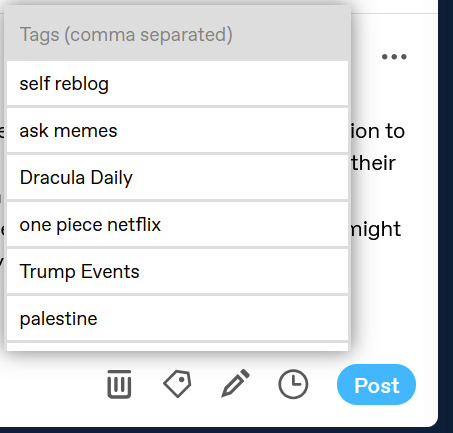
75 notes
·
View notes
Note
Hello! Just want to say that I absolutely adore your designs for Jon, Edward, and Jervis! They're so detailed and extra. I love them sm. Up in the top two favorite designs. My favorite is definitely Jervis. Which is funny, because in just about every version he's my least favorite of the three. His design is just so fun and goofy and him. It's amazing. They all are.
Anyways that's it. Byeeee<33
Oh? Do you now? Well I’m glad you think so because now you’re getting
Design Notes — Riddler | Scarecrow | Hatter
I drafted up some rogue designs last year, actually. They’ve mostly evolved from those. Content warning for horrific old art.
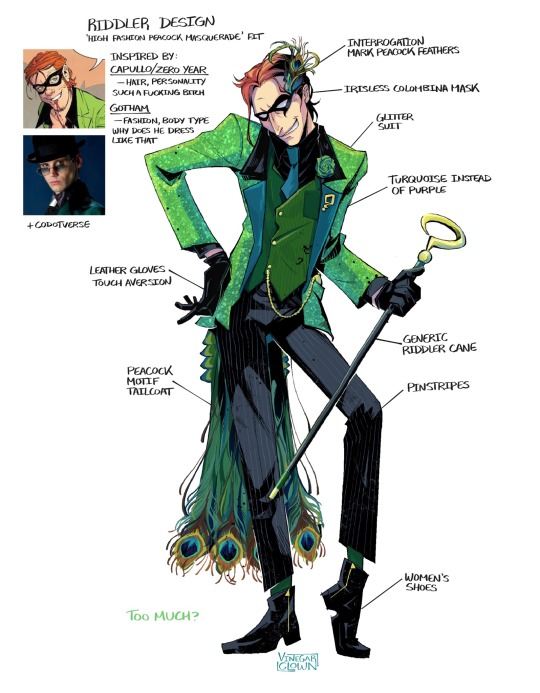


The McGriddler — Ah, a grown man with the strength of a baby! I’ve actually had this… horrendous peacock concept in my brain since 2022, back when my Riddler design was a dirty blonde/brunette. I hated him. He had the costume, but not the flair. Not to mention the generic facial structure.
Luckily, New Riddler is now an ostentatiously dressed vain attention whore! Highly fashionable, extensive wardrobe (def designing more outfits for him) and a possible mid-life crisis arc where he just wears a bathrobe and wifebeater for a month straight.
And listen, I’m not much of a writer, but there are notes on his personality.

Not great ones, though.
And rather than his ambiguous forensics/science job, he now works in I.T. Or rather, worked in I.T. (fired for patronising tech support customers)
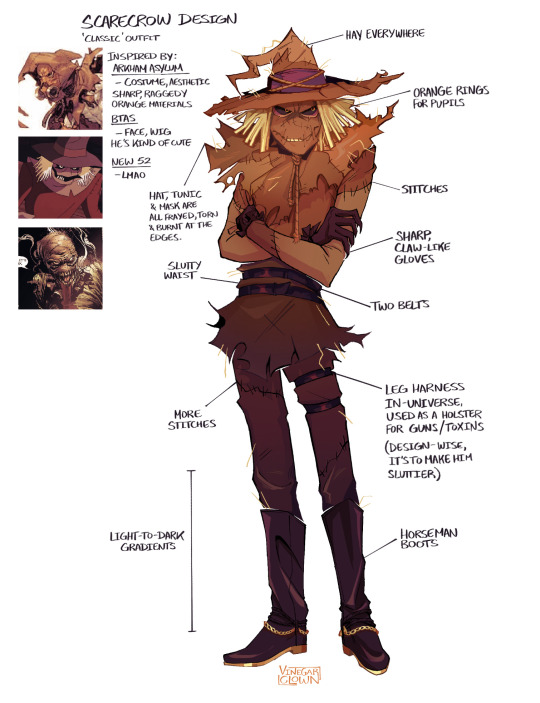

For Jon — He’s always had black eyes with orange ringed pupils (initially blue) from the fear toxins. Drafted him up in high school because I was coping.
I’ve always intended to give him multiple costume designs. With narrative purposes. He redesigns himself. Ofc he couldn’t be satisfied with one thing, no, he has winter, summer, Witch Doctor, stealth etc. costumes on the way.
The initial design was trying to do too much — Patches, stitches, belt straps, arm warmers, utility belts, boots. Clutter. (Does NOT help that I can hardly decipher my old sketches.)
So, we just remove the overtly slutty components from the main design—

—And put them in a seperate campier Scarecrow design that I use as a Halloween-sona.
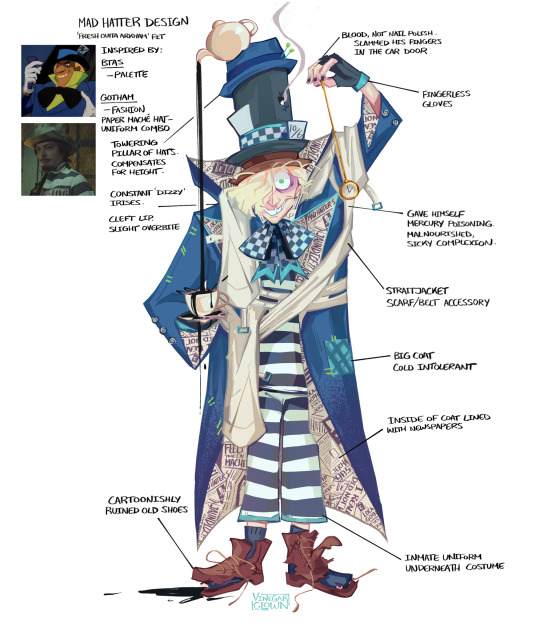
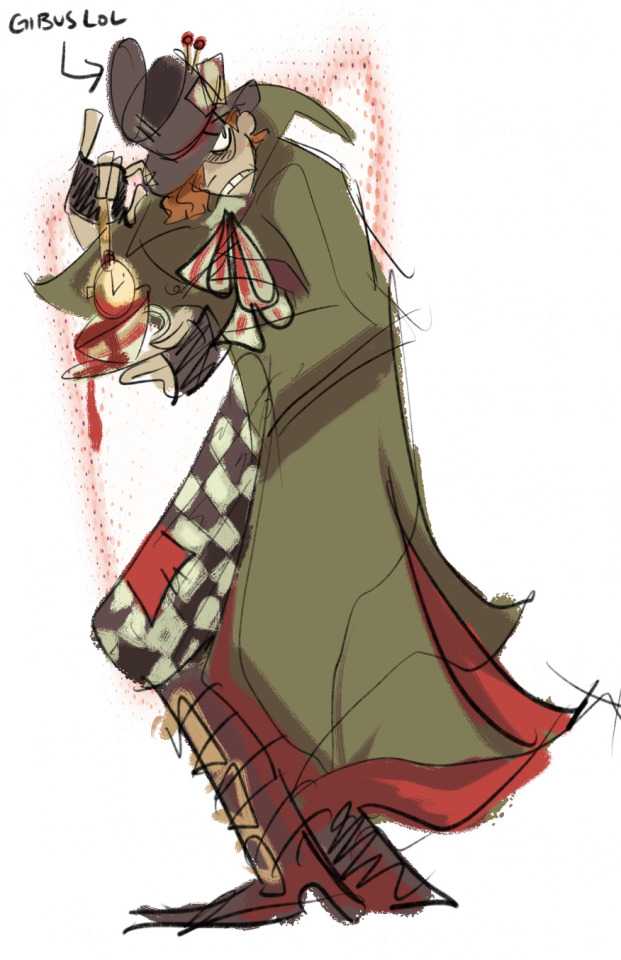

Silly Crazy Zonka Wonka — I think I was looking at pics of the Depp Hatter for the old design, which. May explain some things.
Acute observation! They look nothing alike. So I’ve kept absolutely nothing from the initial design except for the choppy wavy hairstyle.
Completely different colour scheme. Subbed out the TF2 Ghastly Gibus for the Towering Pillar of Hats. (Because ofc The Hatter would have something from the funny Hat FPS, no?) Shorter. Feebler. Every sickness on the planet. Congratulations! Mercury poisoning.
The initial concept for the redesign was to have a sort of reversible coat with his Arkham outfit on one side, and Rogue outfit on the other. You can see I just opted for him to wear a combination of both.
#vclownverse#I fucking hate my riddler if you couldn’t tell#design notes#character design#batman#the riddler#edward nygma#scarecrow#jonathan crane#jervis tetch#mad hatter#digital illustration#creaman#batman rogue redesign#batman rogues#old art#vinegarclown#fanart#creaman-answer-sheet.pdf#gamer scarecrow
388 notes
·
View notes
Text
Patriarchal Culture Masterlist
To make my resources more accessible, I am now going to have separate posts linking to each of my feminism subcategories. These are intended to catalog my resource posts, not every post on my blog.
This is the masterlist for my #patriarchal culture tag, which includes (but is not limited to) posts on economic inequality, abortion, gender stereotypes, and the beauty industry.
Most of these posts are mine, but I will include the occasional resource from others.
Please see my main masterlist for other topics.
This post will be edited to include further resources, so check back on the original post link for updates. (Last update: 03/2025)
Prevalence and Impact of Patriarchy
Misogyny causes the loss of millions of women per year.
Around the world, many men endorse misogynistic beliefs and behaviors.
Economic Inequality
The gender pay gap still exists and is driven by the sexist structure of the workforce.
As women move into a field, the pay for that field drops, which is driven by devaluation of women and the sexist structure of the workforce.
Women do the majority of unpaid labor and their work is devalued and disregarded.
Women are equal or better corporate leaders than men.
Men still hold most economic power in the Western world.
There is substantial gendered economic inequality around the world.
Social and Legal Systems
Criminal justice:
There is not a criminal sentencing gap caused by sex.
Women who commit sexual assault do not get lighter sentences because they are women.
Marriage:
The benefits of marriage are much weaker for women than men, and may be eliminated by other social support networks.
Women’s career success is associated with divorce if the couple endorsed traditional views on gender or the woman is dissatisfied with the marriage, but not otherwise.
Men are more likely than women to leave their severely ill spouses.
Children/custody:
Child support and alimony are not discriminatory against men; they are simply extensions of the social contracts you agreed to.
Children raised by both parents, just their mother, just their father, or same-sex parents all have similar outcomes once adjusted for socioeconomic factors and life transitions.
Custody courts are not biased against men.
Politics:
Men still hold most political power in the Western world.
Women are equal or better political leaders than men.
There is not a sudden rightward shift in young men’s politics; men have simply always been more conservative than women.
Feminists opposed the male-specific draft.
The 4B movement is a female separatist movement, not a sex strike or political lesbianism.
Many countries have yet to ratify CEDAW: the Convention on the Elimination of All Forms of Discrimination Against Women.
Other:
There is not a boy’s education crisis.
People generally find women equally or more qualified than men to lead.
In the developing world, patriarchal religions are strongly associated with misogyny and homophobia.
Women’s mobility around the world is severely restricted either formally or informally.
Beauty Industry
Women are impacted more by body image issues and sexualization in society.
Misogyny has restricted women’s diets for millennia.
Young girls' clothes are sexualized.
There is a general attractiveness advantage for both men and women, except in some industries where attractiveness may actually harm women’s outcomes.
Women experience a general advantage when wearing makeup, except for in some male-dominated environments where it harms them.
The “choice” to wear makeup is simply acceding to the path of least resistance.
Makeup perpetuates capitalism, racism, sexism, and necessitates harm to the environment and animals.
Gender Stereotypes
Women are better drivers than men.
Women are better drivers even after adjusting for driving time/conditions.
Men do not have higher IQs than women.
Men are not better at mathematics/coding.
Men’s greater performance on cognitive tasks is eliminated when the stereotype threat against women is eliminated.
Men do not feel more sexual attraction than women.
Men’s and women’s sexual responses are more similar than commonly suggested.
Medical Misogyny
Abortion:
Abortion should be available because women have a right to bodily autonomy.
Access to abortion should not be restricted to women who have the “right” attitude about it.
There is much greater public support for abortion access now than in the past.
Forcing women to have children does nothing to address systemic issues in society.
Other:
Women are harmed during menstruation around the world.
Sexual Behavior
BDSM/Kink:
Roles in kink are heavily gendered, and men are generally more likely to engage in kink.
Submissiveness is associated with reduced sexual arousal in women.
Sexual dominance is not "biological," and such arguments are irrelevant anyway.
Sexual violence is common in BDSM.
The way society talks about sex often positions penetration as an act of dominance and being penetrated as submissive.
Consent:
Men understand nuance in consent; they simply find it convenient to pretend not to.
Incels make a choice to identify with a movement that encourages and perpetuates violence against women.
Sexual violence is not a sex act that is violent but a violent act that is sexual.
The responsive model of sexual attraction raises concerns about sexual coercion.
Other:
Men’s desire for a virgin partner is hypocritical.
The response to male and female victims and perpetrators is similar.
Birth control is more effective nowadays but still existed in history; motherhood is not a requirement of womanhood.
Commentary on the power differential in heterosexual sexual intercourse.
Biology vs Culture
There are no major differences between men’s and women’s brains.
A recent study using machine learning does not prove the idea of brain sex.
Biology does not explain gender stereotypes.
It is unlikely male sexual selection drove sexual dimorphism in humans.
History
There are many theories on the patriarchy’s origins, none of which are confirmed.
Men were not the sole builders of civilization, and such characterizations are misogynistic.
Men have erased women’s contributions from history.
Other
There is not a male-specific loneliness crisis, just a general loneliness epidemic.
Men commit suicide more often, but women attempt suicide more often; this difference is largely driven by differences in methodology.
Male circumcision is not equivalent to female genital mutilation.
All same-sex attracted people experience homophobia.
There is still child marriage in the USA.
24 notes
·
View notes
Text
NHL for rookies || pt. 1

Basic knowledge of hockey and its rules is expected going into this.
══════════════════════════════════════════
Overview of this part:
Teams - history, the Original six, important staff members
League structure - conferences, divisions
Season structure - preseason, regular season, mention of the playoffs (will be a separate post)
Organizational structure - the Board of Governors & the commissioner
══════════════════════════════════════════
NHL or the National Hockey League is the most esteemed professional ice hockey league in the world, founded more than one hundred years ago in 1917.
It belongs to the "Big Four" leagues — NBA, NFL, MLB, and NHL — which are the most prominent and wealthiest professional sports leagues in the US and Canada.
══════════════════════════════════════════
TEAMS
Currently, there are 32 teams — 25 in the US and 7 in Canada.
In the beginning (1917) though, there were only two — Montreal and Toronto.
After Boston, Chicago, Detroit, and New York Rangers joined in the 1920s, they formed what is to this day known as Original Six.
They served as the league's only teams for 25 seasons until further expansion happened.
To this day, the Original Six has the most combined Stanley Cup titles in the league.
They are among the most valuable teams in the NHL, as well as the most scrutinized and harshly judged by the public and experts.
Generally, it is considered a privilege to play for any of the Original Six teams (even though they haven't belonged to the most successful ones for a while).
══════════════════════════════════════════
Important staff members in the teams' structures — aside from the coaching staff:
GM (general manager) is the person who:
hires, fires, and supervises the head and assistant coaches, scouts, and all other hockey operations staff members
negotiates contracts with players and their agents or their current teams
responsible for acquiring and trading players
oversees the drafting process
calls up or sends down players to/from the AHL
manages the salary cap

President of the Hockey Operations:
above the GM in the organizational structure — oversees him
serves as a buffer between the GM and the team owner — ensures the hockey department aligns with the ownership's vision
can veto the GM on decisions
sets long-term direction — rebuilding...
handles high-level negotiations and disputes
.
.
.
Scouts — two types - amateur and professional:
Amateur scouts evaluate young, draft-eligible players in junior, college, and international leagues.
Their goal is to identify future NHL talents
Because of that, they travel extensively all over the world.
Their task is to put together a profile of young players that talks about the player's skating, hockey IQ, skill, and potential.
They also interview players, coaches, and families to evaluate the kid's character.

Professional scouts evaluate players already in pro hockey (NHL, AHL, European leagues).
They help with trades, free-agent signings, and call-ups.
Their job is to analyze players on other teams and find trade targets — players that would fit the specifics the team is currently looking for.
Provide reports on players the team may face in the upcoming games.
Tracks team's own minor-league prospect for potential call-ups.
══════════════════════════════════════════
LEAGUE STRUCTURE
The teams are divided into TWO CONFERENCES, based on the geographical positions — Eastern and Western.
Each conference is then further divided into TWO DIVISIONS.
The Eastern Conference has Metropolitan and Atlantic divisions.
The Western Conference has Central and Pacific divisions.
══════════════════════════════════════════

The map of the NHL divisions.
══════════════════════════════════════════
STRUCTURE OF THE SEASON
The NHL season is divided into:
A preseason (that covers September and early October) includes...
Development camp and prospect tournaments that feature prospects the teams have drafted (both signed and unsigned), as well as specifically invited players from any other hockey league who haven't been drafted or signed by any NHL team yet but whom the teams are interested in.

Training camp begins in mid-to-late September.
The team invites and evaluates around 50 players to put together their roster for the follow-up season and begin the training.
Even the players who are considered stable members of the roster attend this camp and are expected to prove themselves to the coaches.
Primarily it is for the young prospects who have the potential to make the team to show up and convince the coaches that they deserve a spot on the roster & for the new additions (traded players) to show their abilities and how they click or not with the new team.

It is followed by 6-8 exhibition not-for-the-record games that allow the coaches to evaluate their choice of the roster for the following season by seeing it play a game against other teams.
══════════════════════════════════════════
A regular season (till mid-April)
Predefined schedule — since 2021 the regular season consists of 82 games, out of which half is at home and half on the road.
To be precise, 26 out of those games they play against the teams from their division; 24 against the teams from the teams from the other division of their conference; and 32 remaining against every team in the other conference — two (home and road) against every team.
2 points are awarded for a win, 1 point for losing in overtime or a shootout, 0 points for a loss in regulation.
══════════════════════════════════════════
The playoffs (from April to the beginning of June)
Details will be explained in another part as there are a lot of important details that need to be said and explained.
══════════════════════════════════════════
ORGANIZATIONAL STRUCTURE
The ruling and governing body of the NHL is the Board of Governors.
Each team appoints a Governer — usually, it's the owner of the club — and two alternates.
The board establishes the policies of the league, concerns itself with the salary caps for member clubs, approves purchase/sale/relocation of a team, hires/fires the commissioner, and others.
It meets twice per year in June and December.
The chief executive of the league holds the title of the commissioner.
He leads the negotiations on behalf of the league and appoints officials for all games.
The position was established in 1993 and it has yet to experience a change as it still is Gary Bettman who is not a very well loved person among fans.
If you're asking why he's still the commissioner, it's because he made the owners of the clubs filthy rich back in the day (still does) and works primarily for them (not us, the fans) — satisfying all of their needs, and taking most of the bullets for them.
And since the owners of the clubs are mostly old filthily rich men, you can't expect progressive thinking from them, including a fair rotation on the spot of the commissioner — because what if there came someone who would go against them, right?

══════════════════════════════════════════
What to expect in the future parts:
Draft explained
Playoffs explained
Salary cap and contracts explained
How taxes nowadays make some teams more lucrative than others
Rebuilds explained
...and many more
══════════════════════════════════════════

19 notes
·
View notes
Text
Rafelson regards The Monkees, so obviously patterned after The Beatles, as losers, and he counterpoints their escapades and songs with a gallery of his own favorite losers - Victor Mature, Timothy Carey, Annette Funicello, Sonny Listen, Carol Doda, TC. Jones, and Ray Nitschke. Key scenes with The Monkees are extensions of their own personalities and interests - e.g., Peter Tork's involvement in Eastern mysticism inspired a funny sequence with a guru (Abraham Soafer). That the Monkees are not the Beatles, indeed, allows Rafelson to comment implicitly on the place the Liverpudlians actually do occupy in our imaginations - just as he so deftly turns back our old movie fantasies upon reality. The structure of Head is like one of those Chinese boxes within boxes within boxes within boxes, stretching into infinity. This is highly appropriate since the box is Rafeison's central metaphor. For much of the movie The Monkees are literally as well as figuratively 'boxed in' and trying to free themselves from their manufactured images.
i found this in my drafts no idea where it's from based off of the (now fixed) typos probably some crusty pdf
18 notes
·
View notes
Text
I've been thinking a lot about AUs lately, so in no particular order, here's a few that never made it out of the drafts:
Devil Fruits are sentient beings comparable to daemons, but they still give you powers. Only people with a devil fruit can see them, so Cora has to go through his mission hiding both his own devil and pretending he can't see the others.
Modern Fantasy AU where Law saved Cora's life with a spell of sympathetic magic: any injury Cora gets, Doflamingo does too (and vice versa). If he wants to live, Doflamingo has to keep Cora alive and safe (and Law too, since Cora has no qualms hostaging his own health and safety to negotiate for Law's protection). (Also, Cora and Doffy are demons.)
After his defeat in Dressrosa, Doflamingo ends up back in time, in Spider Miles. He decides that the best way to ensure his future success is to keep Cora alive and convince him (and, by extension, Law) to stay with him. He is not in denial about having missed his brother at all, no way, this is all strategy.
Not technically AU, but a pre-canon fic about Marine era Cora's ship being attacked by a sea king, with the tone and structure of a creature feature. With his commanding officer dead, a twenty-year-old Cora is left as the man in charge of the crew, who definitely resent him for his age and position, while they're all stranded in the Calm Belt and with the monster waiting for them to sink.
Sengoku dies (RIP) and Doflamingo ends up becoming a Warlord much sooner than in canon. This means he meets his brother as a Marine, while Cora is a) not on a mission to stop him and b) grieving the death of his father figure. Doffy sees the latter as an opportunity and decides to manipulate Cora into joining him. This will definitely end up with Doflamingo becoming a much better person entirely accidentally. (This one's something of an iteration from the time travel one.)
Modern AU Crocodile/Buggy/Cora (yes I CAN write ship. I know, it's wild) (I have periods of writing/reading ship before getting bored and going back to Gen fic) Very trope-y Teacher/Parent(s), in which Buggy is Law's teacher and absolutely intimidated by Crocodile, but also trying to figure out what the hell Law's home situation is. Also Buggy is French Canadian because my girlfriend asked for it.
Another modern fantasy AU, this time with Cat Shapeshifter Law on the run after the death of his parents and sister, being picked up in cat form by Cora, who is quite worried about this injured kitten. This one was really just me thinking "aw man I sure love cats" and then writing about it for a couple thousand words.
At the same time baby Doflamingo unlocks his Conqueror's Haki, baby Cora develops very intense Observation Haki. This is another "What if Doflamingo didn't suck?" AU
Platomic Soulmate AU where Cora's soulmates are Doffy and Law. You share pain with your soulmate, but Cora refuses to share his pain with anyone else. Very much a literalization of him being torn between his loyalties. I stopped writing this because it just got too sad.
Croc/Cora (and also Croc/Mihawk/Buggy) Arranged Marriage AU. I really like those comics where a girl gets transmigrated into a novel and becomes the villain, or a girl ends up back in time and resolves to do things better this time, and this was really just me reading way too many of those while taking a class on Elizabeth the First. Heavy on the political drama and evil Doffy.
I've never been sure if this one was going to end up AU or not, but for the prompt "Mind Control" for last Whumptober, I started a fic in which a devil fruit user compels Doffy to almost kill Cora. For the angst. (Then midterms happened and all hopes of doing Whumptober died.)
(Feel free to shoot me an ask (or reply/reblog, whatever boats your float) about any of these! Most of them have at least something written for them or are fairly thoroughly plotted out, so I can tell you more if you're curious.)
#i cannot write short summaries worth a damn#i was trying to keep them short and sweet but i fear they are borderline incomprehensible#im working on finals and dont have time to write and i need SOMETHING to tide me over to the end of term#so thinking about AUs it is
19 notes
·
View notes
Note
As someone who is also writing fanfics, I wanted to ask, how do you lay out your plot-? I love your writing, the emotions are so strong and so realistic, but even more so, I love your plot. You have great foreshadowing and even better plot twists. Plus, when you change the POV for chapters, it truly feels like a whole different person, which can be hard (for me) when writing. Do you have any tactics you use/would be willing to share?
Oof, good but complicated question. Particularly hard to answer when you believe plotting is your weak point! Maybe that's why I put a lot of effort into it. Okay, here we go... and spoilers for Skeleton Crew.
Most important rule - you can’t foreshadow if you don’t know where you’re going. And you can tell if a writer abandons their original idea, because the end doesn’t feel natural or satisfying.
There are so many ways to plot, but I use the 16 point plot plan. It covers all the key beats, so I can’t ever get really lost. Even when my characters do their own bloody thing without permission (Alastor, Sans, I’m looking at you two), I’m not losing any of the structure or foreshadowing work I’ve done.
https://writershq.co.uk/wp-content/uploads/2018/06/magical-16-point-plot-planner.pdf
When foreshadowing a twist, the biggest fear I have is ‘this is too obvious, everyone’s going to know’. But from experience, few do. I thought for sure everyone would realize Tido was the mole when I laid out the early hints. But I only really remember maybe two or three comments, guessing it might be her.
There’s a belief twists are supposed to be completely out of the blue. Nah. You need to lay the groundwork. “And then the meteor hit” is not a twist if it comes out of nowhere. No one wants a deus ex meteor strike. The twist needs to be a logical extension of the story, not a random plot device.
Knowing who knows what, and what they choose to reveal, is a good way to foreshadow. The way a character speaks can hint at a twist. It can be subtle and written off - a character reminiscing about a dead man in the present tense can be written off as an expression of grief. Twist! He’s alive! It’s an oldie but a goodie.
When I’m writing something with a lot of characters, I keep a little list about who knows what and at what point in the story. It’s useful to keep your facts in order. I wrote a draft of a sci-fi novel (over 100k) before realising that one character couldn’t possibly know what they know and it messed the whole thing up.
*Pained author sounds and redrafting.*
Thematic foreshadowing! Tricky, but worth it, and also requires you to understand your story before putting it on paper. Or the internet. Another classic example - Romeo and Juliet isn’t shy in hitting you over the head with its themes of fate, destiny and tragedy. If it wasn’t clear from the opening lines, the constant messaging of being unable to escape your fate foreshadows where we’re ending up.
In Skeleton Crew, I wanted to explore the idea of picking a side and fighting for what you believe in. The nurse, bless her naïve socks, starts the novel hoped that though her actions are criminal, she was not herself a criminal. That the world is basically good, and she was just fixing a wrong. She starts the novel with a tranq gun and ends it with a shotgun.
Ending with the nurse shooting someone with a shotgun was one of the first things I realised when planning. Everything was leading to that pivot in her character. Because I knew that, I could shape everything around it. By the end, she’s accepted there’s something wrong with the world, and she has to stand up for what’s important to her. Not as a nurse, but as a soulmate and a fighter.
Anyway, forgive the rambly thoughts. If you want further reading, or just better advice from someone smarter than I am, I’d recommend https://jerichowriters.com/what-is-foreshadowing-in-literature/
22 notes
·
View notes
Text
Writing Notes: The Snowflake Method

As a snowflake grows from its center core, it expands in all directions, breaking off into additional branches that give it greater volume and spatial scope.
The snowflake method of fiction writing applies this concept to the craft of storytelling.
The Snowflake Method
Created by author and writing instructor Randy Ingermanson.
A technique for crafting a novel from scratch by starting with a basic story summary and adding elements from there.
How to Use the Snowflake Method
To begin using the snowflake method, think of a story idea and describe it with a one-sentence summary.
Example: “Two teenagers discover a secret cave that contains treasures that a group of criminals has been hunting for.”
The snowflake method then requires you to build that sentence into a paragraph, using that paragraph to create various character descriptions.
From there, you use those descriptions to create a series of storylines that involve those characters. This process of outlining a novel spans outward until you have a fully outlined novel, just as a snowflake expands from a single drop of water.
The 5 Steps of the Snowflake Method
Choose a premise and write it up in a one-sentence summary.
This single sentence will be the foundation for your entire novel’s outline.
Expand that one-sentence summary into a full paragraph.
Use that sentence to write a one-paragraph summary to explain the main story of the novel. It should also identify core characters, and break their narrative into a structure with a beginning, a middle, and an end.
If you wish to conceive of your story with a three-act structure, think about the primary exposition, the inciting action and development, and the climax.
Note that a story can have more than three plot points.
No matter how many you choose, each of these plot points will be a spoke stemming off from the central hub that is your premise.
Create character summaries.
Rooting yourself in the narrative you’ve just written out in a single paragraph, begin to explore the major characters who will populate your story.
What are their core characteristics?
What is each character’s point of view?
What roles will they serve in relation to the main premise?
Build your character summaries into full profiles.
Now it’s time to add a few more extensions to your snowflake by creating full characterizations from those summaries.
Consider the characters you’ve just roughly sketched and ask:
What is each character’s name?
Which of these will be the main character?
What are their biographies and backstories?
How will each character’s goal, each character’s conflicts, and each character’s epiphanies help them overcome those conflicts?
What do they look like?
What are their affectations?
Expand to a multi-page synopsis.
By this point, the snowflake method has generated a core story, a multi-part plot structure, character names, & multiple character profiles (or character synopses).
You are now ready to expand these elements into a brief 4-page synopsis.
As you encapsulate the whole story in full pages, focus on a list of scenes, who is in them, and what events will occur in them.
Are there any major disasters?
Remember that every event is building toward the end: the story’s climax.
A great story with a weak ending will quickly be forgotten.
Once you have these elements drafted, your literary snowflake is complete, and you’re ready to dive into the first draft of your novel and start writing fiction!
Source ⚜ Writing Notes & References Writing References: Worldbuilding ⚜ Plot ⚜ Character
#on writing#snowflake method#writing tips#writing advice#writing exercise#writeblr#dark academia#spilled ink#writing reference#creative writing#writing inspiration#writing ideas#writing prompt#literature#writers on tumblr#poets on tumblr#poetry#m bleichner#writing resources
184 notes
·
View notes
Note
Hii! I know I said it before but I genuinely do love your work, I couldn't stop thinking about it and it even inspired me to write some docs about Rúben [they're hidden in my drafts for now hehe]!
I said that I ranted about your neighbour!Rúben fic to my friend, and that a couple ideas sprouted into my mind.
My favorite idea was probably a part 3 with Rúben starting to pine after you and you also thinking about him in a similar/same way! I just thought it would be cute to see how Rúben would think about you and care for you in the slightest of ways [like how he would bring you dinner when you get home late, or offer to give you a ride to the university]. The way you ended part 2, telling Rúben that you appreciate him, felt like you deepened their relationship and perhaps the growing intimacy that they have.. especially the part with the eye contact.. the tension had me squirming and giggling!!
Part 3 could also go in a way where he starts to notice things about you that he didn't notice before, and you do the same. Although he's been to your apartment more than a few times, he's never really noticed the tinier things like how you have an extensive candle collection [you can never stop yourself from stopping in the home aisle and smelling different candles], or, for you, the way he has a few poetry books in Portuguese that he likes to read from time to time [who knew Rúben was quite the romantic?].
Obviously these are just a few ideas that you can implement into part 3, if you do happen to write it. But honestly whatever you do write would be amazing because you just have some sort of talent, something I can't really put my finger on but I want to keep coming back to read your work.
There is just this something about the way you structure, write and describe things that really immerse readers, like myself. It's almost like youve written this in a way that this exact situation could happen in real-life, it feels so seamless and natural to read.
I hope you are taking care of yourself and making sure that you're eating well and saying hydrated, especially in this summer heat! Make sure that you keep yourself happy and have a lovely day or night, much love and kisses 🩷
i actually feel so,, honored and proud that you talked to your friend about something that i wrote. just feels… surreal. and it makes me feel so happy and appreciated! seems like i do have a few good writing skills!!
generally, i always try to make my fics as natural as possible. i don’t think that those super detailed and maladaptive things are something that one might enjoy to read. that is why i try to make things happen in a natural environment! and it seems like you noticed it, which makes it all more worth it!
to be honest, i did think about making rúben fall for reader first, at the same time i am also someone that tries to portray the characters as realistic as possible. therefore, i believe that rúben would be very subtle when falling in love with someone.
next chapter would probably be in readers point of view! and i think reader is somewhat oblivious, or not really looking for something like that since she never really had the time to have a relationship.
but i love your points with rúben being kind and helpful towards her, noticing new stuff and all that!!
i genuinely thank you so much for your kind and encouraging comments, i hope u have the best day and maybe soon i’ll start working on the next part!!
34 notes
·
View notes
Text
by Michael Starr
1. The IDF is winning, and needs to be allowed to win
Compared to their operations during my first tour at the end of 2023, there is a sense that Hamas is collapsing. The terrorist organization once fielded ambush cells that conducted frequent hit-and-run anti-tank missile attacks and ambushes from a wide network of bunkers and tunnels for a guerilla defense-in-depth strategy.
Almost a year later, Hamas seems unable to operate on a strategic level, even from areas in which its battalions have remained structurally intact or reconstituted from degraded units. This is exemplified by Hamas’s inability to launch targeted reprisals for the death of military leaders or even attempt traditional attacks on Jewish holidays or the anniversaries of October 7.
By and large, they do not operate at night or the light of day, clinging even closer to the low visibility of dawn and dusk, whereas their operatives would once openly operate in daylight hours due to being able to escape underground after an attack. It appears that their tunnel networks have been greatly compromised, as they have had to travel along roads and weave between buildings.
Their legitimate operations focus on improvised explosive devices and lone sniper attacks rather than using heavier munitions, but a greater focus has been filming any engagement so that they can edit the footage and claim to foreign supporters and Israeli citizens that they have destroyed Israeli vehicles. Stealing humanitarian aid was apparently not enough for some Hamas battalions, as in one case, they resorted to sending plainclothes operatives to loot food and supplies from abandoned IDF positions.
Their mortar bombs fall far less accurately than they once did, and we did not encounter any enemy drone activity. The Netzarim security corridor seems relatively safe, with paved roads and outposts enjoying electricity provided by power lines.
While many soldiers left Gaza positive about the IDF’s advancements, the path to victory is long, and the journey should not be confused with its destination. Many soldiers have mixed their sense of Hamas’s significant degradation with the feeling that the military is being held back from decisive action, entering and leaving areas to allow Hamas to retain territorial control.
3. Gaza was far from an 'open-air prison'
One of the great shames about the extensive damage to Gazan infrastructure is that it was not the desolate “open-air prison” that it had been advertised as being in anti-Israel propaganda. While there certainly were residents living in desperate conditions, the houses, apartments, and villas that we cleared and took position in had a decent and even opulent quality of life. All the homes we saw had televisions, computers, refrigerators, decorations, and stores of food similar an Israeli suburb.
Our impression was not one of squalor but normal conditions. In rural areas, villas and mansions oversaw sweeping vineyards on one side and a view of the ocean on the other, and in urban areas, large schools, restaurants, and other facilities. The lost potential and degraded conditions in Gaza make Hamas’s decision to attack Israel and weaponize its territory - rather than develop what they held - even more of a shame.
4. Hamas weaponized Gaza
Much has been said about Hamas’s use of civilian shields to deter IDF operations – a detained civilian told our troops that he was unable to travel from the north to the south along humanitarian corridors because he had to bribe Hamas operatives who were bent on keeping civilians around them as cover. Yet the civilians are just one aspect of Hamas turning Gaza into a weapon to try to destroy Israel.
Tunnel networks are not just placed around or under civilian objects; terrorist infrastructure is integrated into civilian infrastructure in a way that makes the two indistinguishable. Civilian homes are turned into lookout and reconnaissance outposts, with members of families hired by terrorist organizations to provide intelligence, as was exemplified by the capture of spotters by a neighboring battalion.
Armories are hidden within houses to be accessed by plainclothes terrorists when they have the need to shed the veneer of being civilians. Tunnel entrances can be found on the first floor of apartment buildings, not just in their backyards. Other homes are booby-trapped, leading to widespread suspicion of each home being laced with explosives. With Gaza being weaponized in such a fashion, it has led military units to take precautions and actions that damage buildings and homes so that they can stay alive.
14 notes
·
View notes
Text
The Kingdom of Mossland
KoM 2-9 | The Defense of the Realm
The armed forces of the Kingdom has been a long running and ever changing part of this build. A coastal fort was one of the first things I built in the city but it was very blah and I tore it down and put a scientific academy in it's place. But ever since then, I wanted some sort of structure that would act as the center of the Kingdom's defenses. Originally, this would have been a large fort guarding the harbor, but that area has been rezoned as part of the city. And then I realized I had never really expanded the Kingdom to the south and went looking around for some building inspiration, and I found the fort I had been looking for.

Fort Maillard
Built on an island guarding the southern entrance into the city, Fort Maillard is the home of the Kingdom's armed forces. Here, soldiers are armed and trained to defend the realm from the hordes of zombies and skeletons that plague the land. The fort also is the home of the Officer's School, where strategy and command is taught through extensive wargaming (this was an actual thing in history, not just something nerds do. There is also a Royal Surveyors team that has a bitter one-sided rivalry with the Explorer's Guild, who have replaced them as the realm's foremost cartographers. But the most important inhabitants of the fort, are the River Watch. These soldiers are responsible for guarding the Kingdom's many rivers, and have earned themselves a legendary reputation as the shields of the realm.


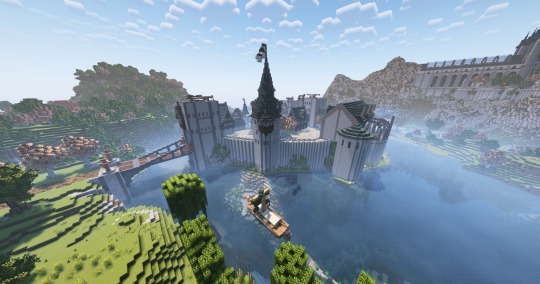
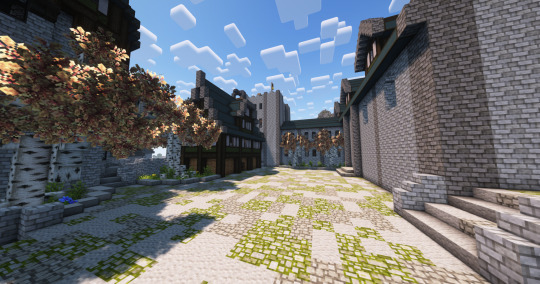
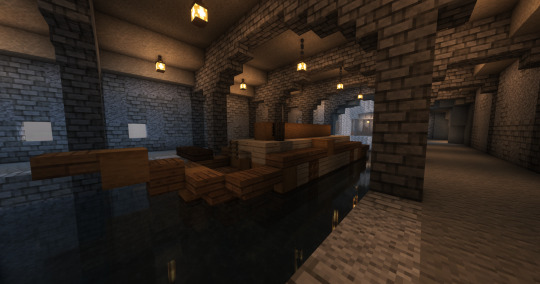


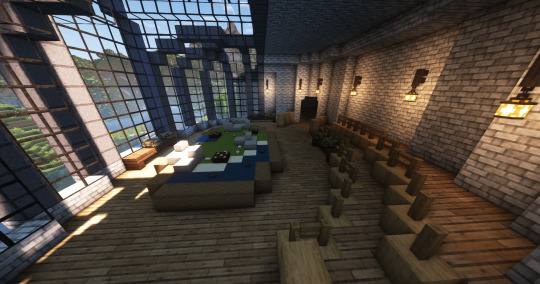
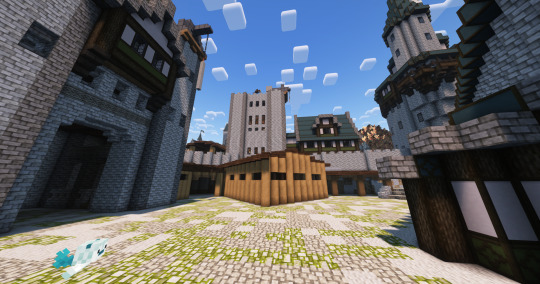
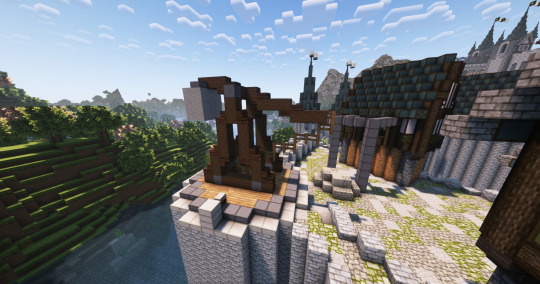

The River Watch
Responsible for the defense of the Kingdom's waterways, the River Watch have outposts and watch towers all over the Kingdom. Combined with their signature narrow boats, this network of watchers and boats allows the River Watch to quickly respond to threats all over the realm.



Their boats have collapsible masts to allow passage under low bridges, and a shallow draft, to avoid grounding out in shallow waters. The boats are equipped with sleeping areas, and a small kitchen, allowing the crews to stay on the river for extended periods of time. The inspiration for these boats are the narrow boats common to the canals of England. I reeeally wanted a cool name for the boats and the group, similar to how the Night's Watch in Game of Thrones are called Crows, but I really couldn't think of a river themed version. The Toads? The Swans? They all seem kinda lame.




The River Gates
The last thing I built was the river gates that guard the northern entrance into the realm's rivers. These gates are built into a cavern under the city and work together with the drawbridge to make unwanted passage into the Kingdom nearly impossible by river.





I know this was a long one, but larger builds to flesh out the project was my goal with the whole "Season 2" thing. I also have a job that mentally drains me, and my willingness and availability to sit and play Minecraft is not what it used to be. But I still like playing it. I recently joined a modded survival server with some people for the first time, but they all gave up by the end of the first week, which really sucked, so I came back to my kingdom. I have actually been debating calling a hiatus (or just an end entirely) on this and starting a new project. I feel like a new build style would be nice to explore, but at the end of the day, I am just one tired guy who has to accept he can't play as much Minecraft as he wants to.
*Fun fact, Fort Maillard gets it's name from the Maillard reaction, which is a chemical reaction that causes pretzels to develop that brown pretzely goodness when they are baked*
#minecraft#minecraft creative#minecraft build#minecraft aesthetic#mineblr#minecraft mizunos#mizunos 16 craft#minecraft cottagecore#minecraft worldbuilding#minecraft castle#minecraft screenshots#minecraft city#minecraft inspo#minecraft inspiration
24 notes
·
View notes